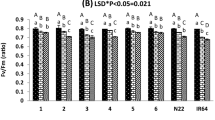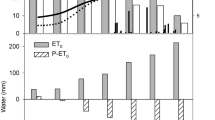Abstract
Drought stress at reproductive stages is mainly responsible for low yield in pigeon pea especially in semi-arid regions. Understanding genetic makeup at the phenotypic and genotypic level for stress tolerance-related traits is critical for the selection of diverse parental lines and in designing the breeding program for genetic enhancement of the crop. In view of this, we assessed the responses of different pigeon pea genotypes under irrigated and drought stress conditions for two consecutive years through morpho-physiological characterization and genotyping using SSR markers for assessing diversity at the genomic level. The study revealed high genetic diversity for morpho-physiological traits of which photosynthesis and water use efficiency were found to be useful in screening for drought tolerance. Cluster and PCoA analysis revealed diverse genotypic groups by stress tolerance and maturity duration. Genotyping using genic and genomic SSRs revealed 109 unique alleles with an average of 2.09 alleles per marker with the average polymorphic information content (PIC) value of 0.28 and a range of 0.09 to 0.60 between genotypes. This study helped in identifying diverse genotypes with stress tolerance and provide an insight for the selection of parental lines for using them in the genetic enhancement program in pigeon pea.




Similar content being viewed by others
Availability of Data and Materials
All the data and plant material are available from the corresponding author. The original contributions presented in the study are included in the article/Supplementary Material; further inquiries can be directed to the corresponding author.
References
Bartlett MS (1937) Properties of sufficiency and statistical tests. J Royal Stat Soc America 160:268–282. https://doi.org/10.1098/rspa19370109
Blum A (2011) Drought resistance—is it really a complex trait? Func Pl Biol 38:753–757. https://doi.org/10.1071/FP11101
Bohra A, Dubey A, Saxena RK, Penmetsa RV, Poornima KN, Kumar N, Farmer AD, Srivani G, Upadhyaya HD, Gothalwal R, Ramesh R, Singh D, Saxena KB, Kavi Kishor PB, Singh NK, Town CD, May GD, Cook DR, Varshney RK (2011) Analysis of BAC-end sequences (BESs) and development of BES-SSR markers for genetic mapping and hybrid purity assessment in pigeon pea (Cajanus spp). BMC Plant Biol 11:56. https://doi.org/10.1186/1471-2229-11-56
Cary NC (2011) The SAS system for windows. SAS Version 9.3. Procedure Guide. SAS Inc
Choudhary AK, Sultana R, Vales MI, Saxena KB, Kumar RR, Ratnakumar P (2018) Integrated physiological and molecular approaches to improvement of abiotic stress tolerance in two pulse crops of the semi-arid tropics. The Crop J 6:99–114. https://doi.org/10.1016/jcj201711002
Costa Franca MG, Pham Thi AT, Pimentel C, Pereyra Rossiello RO, Zuily-Fodil Y, Laffray D (2000) Differences in growth and water relations among Phaseolus vulgaris cultivars in response to induced drought stress. Env Expt Bot 43:227–237. https://doi.org/10.1016/S0098-8472(99)00060-X
Datta S, Singh P, Mahfooz S, Patil PG, Chaudhary AK, Agbagwa IO, Nadarajan N (2013) Novel genic microsatellite markers from Cajanus scarabaeoides and their comparative efficiency in revealing genetic diversity in pigeon pea. J Genet 92:24–30
Deshmukh DV, Mate SN (2013) Evaluation of pigeon pea genotypes for morpho-physiological traits related to drought tolerance. World J Agric Sci 9:17–23. https://doi.org/10.5829/idosiwjas2013911701
Dutta S, Kumawat G, Singh BP, Gupta DK, Singh S, Dogra V, Gaikwad K, Sharma TR, Raje RS, Bandhopadhya TK, Datta S, Singh MN, Bashasab F, Kulwal P, Wanjari KB, Varshney RK, Cook DR, Singh NK (2011) Development of genic-SSR markers by deep transcriptome sequencing in pigeon pea (Cajanus cajan (L) Millspaugh). BMC Plant Biol 11:17. https://doi.org/10.1186/1471-2229-11-17
Faralli M, Lawson T (2020) Natural genetic variation in photosynthesis: an untapped resource to increase crop yield potential. The Plant J 101:518–528
Flood PJ, Harbinson J, Aarts MG (2011) Natural genetic variation in plant photosynthesis. Trends in Plant Sci 16:327–335
FAOSTAT Statistical Database (2022) FAO: Rome. https://www.faoorg/faostat/en/#home
Geetika G, van Oosterom EJ, George-Jaeggli B, Mortlock MY, Deifel KS, McLean G, Hammer GL (2019) Genotypic variation in whole-plant transpiration efficiency in sorghum only partly aligns with variation in stomatal conductance. Func Plant Biol 46:1072–1089
Gupta PK, Varshney RK (2000) The development and use of microsatellite markers for genetic analysis and plant breeding with emphasis on bread wheat. Euphytica 113:163–185
Gurumurthy S, Sarkar B, Vanaja M, Lakshmi J, Yadav SK, Maheswari M (2019) Morpho-physiological and biochemical changes in black gram (Vigna mungo L Hepper) genotypes under drought stress at flowering stage. Acta Physiol Plantarum 41:42. https://doi.org/10.1007/s11738-019-2833-x
Khalekar GD, Akhare AA, Gahukar SJ, Singh NK, Kumar M (2014) Identification of simple sequence repeat markers associated with wilt resistance in pigeon pea. J Env Biol 35:955–960
Kimaro D, Melis R, Sibiya J, Shimelis H, Shayanowako A (2020) Analysis of genetic diversity and population structure of pigeonpea [Cajanus cajan (L) Millsp] accessions using SSR markers. Plants 9:1643. https://doi.org/10.3390/plants9121643
Kumar Rao JVDK, Dart PJ, Sastry PVSS (2008) Residual effect of pigeonpea (Cajanus cajan) on yield and nitrogen response of maize. Exp Agric 19:131–141
Leakey AD, Ferguson JN, Pignon CP, Wu A, Jin Z, Hammer GL, Lobell DB (2019) Water use efficiency as a constraint and target for improving the resilience and productivity of C3 and C4 crops. Annual Rev Plant Biolo 70:781–808
Liu K, Muse SV (2005) Power Marker, an integrated analysis environment for genetic marker analysis. Bioinformatics 21:2128–2129. https://doi.org/10.1093/bioinformatics/bti282
Lopez FB, Chauhan YS, Johansen C (1997) Effects of timing of drought stress on leaf area development and canopy light interception of short-duration pigeon pea. J Agro Crop Sci 178:1–7. https://doi.org/10.1111/j1439-037X1997tb00344x
Mafakheri A, Siosemardeh A, Bahramnejad B, Struik PC, Sohrabi Y (2010) Effect of drought stress on yield proline and chlorophyll contents in three chickpea cultivars. Australian J Crop Sci 4:580–585
Manyasa EO, Silim SM, Mwangi SG, Christiansen L (2008) Diversity in Tanzanian pigeonpea [Cajanus cajan (L) Millsp] landraces and their response to environments. Gen Res Crop Evol 55:379–387
Nam NH, Chauhan YS, Johansen C (1993) Comparison of extra-short-duration pigeon pea with short-season legumes under water stress conditions of alfisols. Exp Agric 29:307–316
Njunge V, Deshpande S, Siambi M, Jones R, Silim S, De Villiers S (2016) SSR genetic diversity assessment of popular pigeonpea varieties in Malawi reveals unique fingerprints. Elect J Biotechnol 21:65–71. https://doi.org/10.1016/jejbt201602004
Panguluri SK, Janaiah K, Govil JN, Kumar PA, Sharma PC (2006) AFLP fingerprinting in pigeon pea (Cajanus cajan (L) Millsp) and its wild relatives. Gen Res Crop Evol 53:523–531. https://doi.org/10.1007/s10722-004-2031-5
Page RDM (1996) TreeView: an application to display phylogenetic trees on personal computers. Comput Appl Biosci 12(4):357–358. https://doi.org/10.1093/bioinformatics/12.4.357. PMID: 8902363
Paterson AH, Brubaker CL, Wendel JF (1993) A rapid method for extraction of cotton (Gossypium ssp) genomic DNA suitable for RFLP or PCR analysis. Plant Mol Biol Rep 11:122–127.https://doi.org/10.1007/BF02670470
Peakall R, Smouse PE (2007) GENALEX6: genetic analysis in excel Population genetic software for teaching and research. Mol Ecol 6:288–295
Reynolds SG (1970) The gravimetric method of soil moisture determination part I a study of equipment and methodological problems J Hydrology 11:258–273. https://doi.org/10.1016/0022-1694(70)90066-1
Rohlf FJ (1998) NTSYS-pc Numerical taxonomy and multivariate analysis system Version 202i Exeter Publications: New York
Sarkar B, Chakravarthy VSK, Varalaxmi Y, Yadav SK, Vanaja M, Maheswari M (2017) Genetic diversity among pigeon pea (Cajanus cajan L Millsp) genotypes using genic SSRs with putative function for drought tolerance Inter J of Curr Microbiol and App Sci 6:1804–1814. https://doi.org/10.20546/ijcmas2017604216
Singh AK, Rai VP, Chand R, Singh RP, Singh MN (2013) Genetic diversity studies and identification of SSR markers associated with Fusarium wilt (Fusarium udum) resistance in cultivated pigeon pea (Cajanus cajan). J Genet 92:273–280. https://doi.org/10.1007/s12041-013-0266-7
Su R, Chen L, Wang Z, Hu Y (2020) Differential response of cuticular wax and photosynthetic capacity by glaucous and non-glaucous wheat cultivars under mild and severe droughts. Plant Physiol and Bioch 147:303–312
Upadhaya HD, Pundir RPS, Gowda CLL, Reddy KN, Singh S (2005) Geographical patterns of diversity for qualitative and quantitative traits in the pigeonpea germplasm collection. Plant Gen Res 3:331–352
Upadhaya HD, Reddy KN, Gowda CLL, Singh S (2007) Phenotypic diversity in the pigeonpea [Cajanus cajan (L) Millsp] core collection. Genet Res Crop Evol 54:1167–1184
Varshney RK (2016) Exciting journey of 10 years from genomes to fields and markets: some success stories of genomics-assisted breeding in chickpea pigeon pea and groundnut Plant Sci 242:98–107
Winter SR, Musick JT, Porter KB (1988) Evaluation of screening techniques for breeding drought-resistant winter wheat. Crop Sci 28:512–516. https://doi.org/10.2135/cropsci19880011183X002800030018x
Yang S, Pang W, Ash G, Harper J, Carling J, Wenzl P, Huttner E, Zong X, Kilian A (2006) Low level of genetic diversity in cultivated pigeon pea compared to its wild relatives is revealed by diversity arrays technology. Theor App Genet 113:585–595. https://doi.org/10.1007/s00122-006-0317-z
Acknowledgements
The research was carried out under National Innovations on Climate Resilient Agriculture (NICRA) Project at the ICAR-Central Research Institute for Dryland Agriculture (CRIDA). The authors are thankful to the Indian Council of Agricultural Research (ICAR) for providing financial support under the NICRA project for carrying out the present investigation.
Funding
This work was fully supported by the research grant from the ICAR, New Delhi in the form of a national project “National Innovations in Climate Resilient Agriculture (NICRA).”
Author information
Authors and Affiliations
Contributions
BS—conceptualization, analysis, validation, and original draft. VSK—methodology and investigation. VM—resources, methodology, and editing. KS—investigation and validation. MM—supervision and editing. JL—investigation and editing. AK—methodology and editing. SK—review and editing. PM—funding acquisition and project administration. RCG—project administration and resources. VK—manuscript editing.
Corresponding author
Ethics declarations
Ethics Approval and Consent to Participate
All authors understand that the journal Plant Molecular Biology Reporter is a transformative journal. When research is accepted for publication, there is a choice to publish using either immediate gold open access or the traditional publishing route.
Consent for Publication
All authors have approved this manuscript for publication.
Competing Interests
The authors declare no competing interests.
Additional information
Publisher's Note
Springer Nature remains neutral with regard to jurisdictional claims in published maps and institutional affiliations.
Supplementary Information
Below is the link to the electronic supplementary material.
Rights and permissions
Springer Nature or its licensor (e.g. a society or other partner) holds exclusive rights to this article under a publishing agreement with the author(s) or other rightsholder(s); author self-archiving of the accepted manuscript version of this article is solely governed by the terms of such publishing agreement and applicable law.
About this article
Cite this article
Sarkar, B., Chakravarthy, V.S.K., Vanaja, M. et al. Phenotyping Drought-Induced Morpho-Physiological Changes and Genetic Diversity Among Pigeon Pea (Cajanus cajan (L.) Millsp.) Genotypes. Plant Mol Biol Rep 41, 304–316 (2023). https://doi.org/10.1007/s11105-022-01366-2
Received:
Accepted:
Published:
Issue Date:
DOI: https://doi.org/10.1007/s11105-022-01366-2




